2017 Top 100 U.S. Retailers Sales: $2.2 Trillion, Up 4.4%; 142K Stores with Pet Products……plus the Internet!
The U.S. Retail market reached $5.75 Trillion in 2017 from all channels – Auto Dealers, Supermarkets, Restaurants, Online retailers and even Pet Stores. This year’s increase of $235B (+4.3%) topped last year’s increase of $172B and was twice the increase from 2014 to 2015. One factor is that rising fuel prices have put Gas station revenue back on the plus side. (Data courtesy of the Census Bureau’s monthly retail trade report.)
In this report we will focus on the top 100 Retailers in the U.S. Market. These companies are the retail elite and account for 38% of the total market. The vast majority also stock and sell a lot of Pet Products. The retail market is constantly evolving which produces some turmoil – mergers, acquisitions, closures. As you will see, the Top 100 are not immune. The report does contain a lot of data but we’ll break it up into smaller pieces to make it more digestible. All of the base data on the Top 100 comes from Kantar Research and was published by the National Retail Federation (NRF).
Observations
- The total Retail Market grew $235B in 2017 (+4.3%). In 2016 it was +3.2% and in 2015 +2.3%. Growth is accelerating.
- The Top 100 grew $90.9B (+4.4%). This is much better than last year’s +3.5% and slightly better than the market.
- The Top 100 generates $2.2 Trillion in revenue, 37.7% of the total U.S. retail market.
- Let’s make the data a bit more relevant. If you remove the revenue from Auto, Restaurant and Gas Stations, the “targeted” retail market for the Pet Industry is $3.4 Trillion – 60% of the total market. By the way, the slight drop in share is due to the 9% increase in Gas Station revenue.
- If we also remove Restaurant & Gas Station $ from the Top 100, the remaining $2.0T is 34.7% of the total market.
- … and 58.2% of the $3.4 Trillion “target” market.
The Top 100 is critically important and generally outperforms the overall market. However, in 2017 the difference was very slight. Remember, the Top 100 is really a contest. Every year companies drop out and new ones are added. This can be the result of mergers, acquisitions or simply surging or slumping sales. Here are some changes of note in 2017:
- Supermarkets are still undergoing changes. We had 3 drop off the list and 1 addition. Stater Bros and Save Mart simply didn’t have enough revenue to make the list. Whole Foods is also not on the list because it was acquired by Amazon. In the opposite scenario Save-A-Lot is on the list because it was spun off from SuperValu.
- There were 3 other companies in various categories that fell off the list because their numbers weren’t high enough.
- Advanced Auto Parts
- H & M Stores (apparel)
- CKE Restaurants (Hardees, Carl ‘s Jr.)
- Five additions, primarily due to surging sales are: ◦
- Hobby Lobby
- Sephora (cosmetics)
- Discount Tire
- Chipotle Mexican Grill (made it back after dropping off the list in 2016)
- Bass Pro (They acquired Cabelas)
Now let’s start “drilling down” on the Top 100. Here’s a summary of Regular and Online Retailers versus the bundled total for Restaurants & Gas Stations.
- Regular & Online Retailers have 58.7% of the stores but 91.9% of the business, virtually the same as last year.
- Most of the increase (94.7%) is coming from Regular/online retailers. They are up 4.5% compared to +3.7% in 2016.
- Restaurant sales were up $4.8B (3.0%) in 2017 but Gas Stations were down slightly, -$31M (-0.2%).
- The biggest change is the -0.9% drop in store count. This contrasts sharply with a 1.5% increase in 2016. Most of the decrease is in restaurants/gas stations but regular retailers are down too. Could it be an impact of online shopping?
Now that we have an overview of the Top 100, let’s take a look at the “targeted” retailer segment. There are 82 total companies. How many are buying and selling Pet Products? This will reinforce how Pets have become an integral part of the American Household and how fierce that the competition for the Pet Parents’ $ has become.
- Of 82 possible companies, 67 are selling some mixture of Pet Products in stores and/or online. (up from 66 in 2016)
- Their Total Retail Sales of all products is $1.85 Trillion which is…
- 93% of the total business for Regular & Online Retailers in the Top 100
- 32.2% of the Entire $5.75T U.S. Retail market – from 67 Companies who sell Pet Products.
- 57 Cos., doing $1.75T in sales are selling pet products off the retail shelf in 142,000 stores – 3500 more than 2016.
- As you can see by the growth in both sales and store count, in store is still the best way to sell pet.
- Online only is another story and the story gets complicated
- Amazon bought Whole Foods, which has stores so the Amazon $ are now in the “Pet In Store” numbers.
- Many traditional Retailers who only sell Pet Products online are closing stores and losing market share.
- Their Total Retail Sales of all products is $1.85 Trillion which is…
Pet products are an integral part of the strongest retailers and are widespread across the entire U.S. marketplace. Of the Top 100, 142,000 stores carry at least some pet items at retail. There are thousands of additional “pet” outlets including 20,000 Grocery Stores, 10,000 Pet Stores, 16,000 Vet Clinics, 5,000 Pet Services businesses and more. Pet Products are on the shelf in over 200,000 U.S. brick ‘n mortar stores… plus the internet.
Before we analyze the whole list in greater detail let’s take a quick look at the Top 10 retailers in the U.S.
- They did $1.1 Trillion in Sales
- 52.3% of the Top 100’s $ales
- 19.7% of Total U.S. Retail $
- It’s the same list as 2016 (and 2015) but 4 changed rank
- Amazon acquired Whole Foods, broke $100B and moved up to 3rd
- CVS had the only negative performance
In the next section we will look at the detailed list of the top 100. We’ll sort it by retail channel with subtotals in key columns. We’ll then break it into smaller sections for comments.
I have not done a lot of highlighting however:
- Pet Columns ’17 & ‘16 – a “1” with an orange highlight indicates that products are only sold online
- Rank Columns – Change in rank from 2016: (Note: Acquisitions, Divestitures and Corporate Restructuring can cause big changes in ranking.)
- Up 4-5 spots = Lt Blue; Up 6 or more = Green
- Down 4-5 Spots = Yellow; Down 6 or more = Pink
Let’s get started. Remember online sales are included in the sales of all companies
Observations
- Drug is still in turmoil with acquisitions a big factor. Walgreens bought 1900 Rite Aid stores, but closed 600. CVS is in a similar situation. The turmoil may continue into next year as Albertson’s is offering to buy the remaining Rite Aids.
- The Traditional Department store segment continues its overall decline. There are a couple of exceptions in some “high end” stores. However for most, the trend is down.
- Sears (includes Kmart) and Macy’s remain the 2 big “red flags” and more store closings are planned.
- Although all carry a few pet items, generally online, this channel has never fully embraced Pet Products.
- Much of the growth in the Convenience Store Chains in the Top 100 in recent years has come through acquisitions. This continued in 2017 as Circle K acquired CST Brands.
- Military Exchanges/Commissaries have added locations in recent years, which fueled the growth in sales. In 2017 they radically reduced the number of Army/AF Exchanges and opened no new Commissaries. Sales dropped.
- Auto Parts Stores have been a mixed bag. In 2016 only Advance was underperforming in sales. In 2017 they dropped out of the Top 100 and were replaced by Discount Tire. Now this category is showing a big increase.
- Among Apparel retailers, the value outlets continue to show strong growth. All three of these chains carry pet products. Cosmetics stores are also showing surprising strength. Unfortunately, they don’t carry any pet items…yet.
Observations
- Amazon is fomenting the evolution of U.S. Retail. They broke the $100B barrier in 2017 and sales have doubled in 4 years. However, their business is also evolving. With the acquisition of Whole Foods they now have a brick ‘n mortar presence in the market place
- The Phone People – Verizon and Apple, continue to grow, but another bad year for AT&T.
- QVC acquired HSN which moved them up eighteen spots to #40.
- 2017 was a bad year for Toys R Us as sales fell over $1 Billion. However, as we all know 2018 is much worse as they officially went out of business.
- Signet Jewelry’s sales fell 3.9% after an 11% increase in 2016.
- Mass Merchants have 2 of the 4 largest volume retailers in America – Wal-Mart and Costco. In recent years, these two companies have driven the growth in this channel and 2017 was no exception.
- Wal-Mart had a 3.3 increase in sales which is slightly above recent years. Their business is mixed as SuperCenters continue to grow but “regular” Discount Department Stores are losing market share. This trend impacts the overall business in both Wal-Mart and Target.
- Target sales turned around in 2017 after 3 years of flat or declining revenue.
- Costco continues its strong growth (+8.5%), building new stores and increasing sales – both in store and online.
- BJ’s has the only negative story in this channel. Their sales have slowly declined since 2013.
- Home Improvement/Hardware is showing continued strong growth by all “players”. The 2 big guys – Home Depot and Lowe’s are both Top 10 retailers and are doing especially well. Their $9.5 increase in 2017 follows an $8.7B increase in 2016 – up $18.2B in just 2 years.
- Home Goods Companies’ sales were all up slightly, except for Ikea. They restructured their business in 2016 which produced a $2B increase. However, 2017 saw Ikea’s sales fall almost $1B.
- Tractor Supply’s strong growth rate slowed a little (+7.1%). Their average annual growth rate is 8.8% since 2013.
Observations
- Supermarkets – $379B in Sales; 15 Companies; 16,000 stores; All Selling Pet Products. This is a very important group for the Pet Industry. With the highest frequency of consumer visits of any channel, the competition is fierce. The mergers and acquisitions continue. This year we also saw SuperValu begin its exit from the retail grocery business and Amazon’s acquisition of Whole Foods.
- Most companies had slight increases in sales. The big drop correlates directly to SuperValu’s sale of Save-a-Lot.
- Small Format Value Stores: Remember, this retail channel does more business than Traditional Department Stores.
- Dollar General and Dollar Tree are in a virtual tie for Sales, Sales Increase and Store Count. However, it appears that Dollar General is more committed to store growth.
- Dollar Tree’s 2015 acquisition of Family Dollar Stores has proven to be totally seamless.
- Only Big Lots performance is subpar, but they now have 3 consecutive years with small increases.
- This retail channel continues to grow in numbers and popularity. They are committed to Pet Products and their focus on value appeals to today’s ever more price conscious consumers. Plus, they are easy to shop.
- Pet Stores – PetSmart’s huge growth is due to their acquisition of Chewy. Petco made big news last year by qualifying for the Top 100 for the first time at #98. This was evidence of the strength of the U.S. Pet Industry. They had a fair year in 2017 (+3.7%) but it’s a very competitive environment. They barely made the 2017 list at #100.
- Office Supply Stores – This channel is under siege. Consumers are increasingly moving to online ordering.
- Sporting Goods – Sports Authority closed in 2016 but Bass Pro bought Cabela’s. That again gave us 3 Sporting Goods companies in the Top 100. All of them are showing strong growth in both store count and sales.
Restaurants & Gas Stations and the Grand Total
Restaurant & Gas Station Observations
Although restaurants & gas stations aren’t relevant in terms of Pet Products Sales, they are relevant in our daily lives. Also, money spent on rising gas prices and eating out isn’t available to spend on our Pet Children.
- Last year the revenue for Restaurants in the Top 100 was down -3.5%, but it was driven largely by a business re-structuring of Yum franchisees. That is in the past. In 2017 sales are up 3.0%, but the company results are mixed. The biggest “movers” were Chick-fil-A, up $2.6B and Burger King, down -$2.6B. McDonalds also had a good year and Chipotle increased sales enough to make it back in the Top 100.
- Despite rising prices, Top 100 Gas Station sales are down slightly, primarily due a reduction in outlets.
Wrapping it up!
The Top 100 became the Top 100 by producing big sales numbers so it’s not surprising that their performance exceeds the overall market. In 2015 it was more than double – 4.9% to 2.3%. In 2016 it was only 10% better and in 2017 it was only 2.3% better. Today’s incredibly competitive retail market is impacting even many of the biggest retailers in America.
Pet Products are an important part of the success of the Top 100. Sixty-seven companies on the list sell Pet Food and/or Supplies in 142,000 stores and/or online. Let’s take a closer look at the fifty-seven companies that stock pet products in their stores. This group generated $1.75T in total sales. How much was from pet? Let’s “Do the math”. If we take out the $12.5B done by PetSmart and Petco and the remaining companies generated only 1.5% of their sales from Pet, we’re looking at $26B in Pet Products sales from only 55 “non-pet” sources! (Note: The 1.5% share for Pet items is a low end estimate based on data from the U.S. Economic Census.) The APPA reported $43B in Pet Food and Supplies sales for 2017. That means that 55 mass market retailers accounted for 60% of the Pet Products sold in the U.S. in 2017 and… it gets even more focused.
PetSmart & Petco, plus 15 Mass Market Retailers probably account for 75% of all the Pet Products sold in the U.S.
Pet Products are widespread in the retail marketplace but the $ are concentrated. Regardless of your position in the Pet Industry, monitoring the Top 100 group is important. This group also reflects the ongoing evolution in the retail market. We see the growing influence of the internet and importance of Value. The Intense competition is evident in the turmoil of mergers & acquisitions. In business, just like in biology, you must adapt to a changing environment or face extinction!
Finally, here is a link to download the 2017 Top 100 Retailer Excel file so you can do your own analysis.
[button link=”https://petbusinessprofessor.com/wp-content/uploads/2018/08/Top100-US-Retailers2017Ranked.xlsx” type=”icon” newwindow=”no”] Download 2017 Top 100 U.S. Retailers List(Excel)[/button]
.


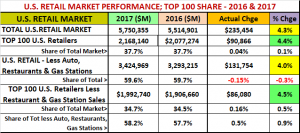



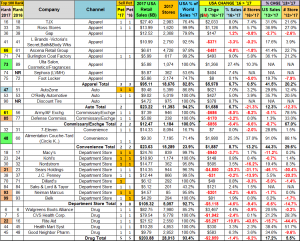
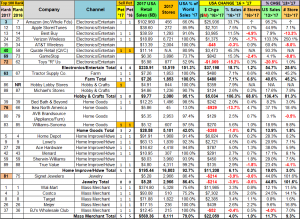
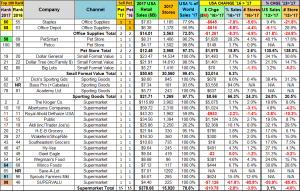


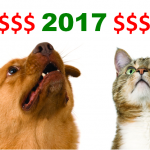
Trackbacks & Pingbacks
[…] and the National Retail Federation on those top 100 retailers, along with his own analysis, on PetBusinessProfessor.com. Though the data doesn’t break out pet product sales from the retailers’ overall sales, they do […]
[…] and the National Retail Federation on those top 100 retailers, along with his own analysis, on PetBusinessProfessor.com. Though the data doesn’t break out pet product sales from the retailers’ overall sales, they do […]
Comments are closed.